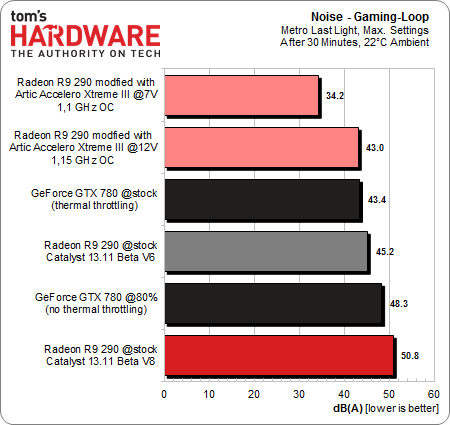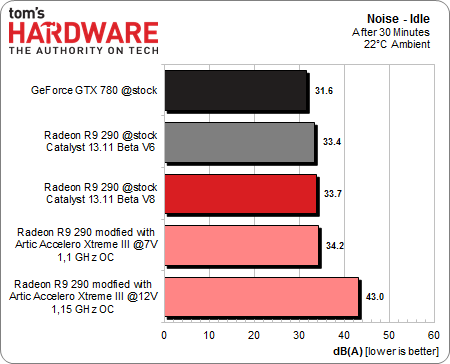AMD Radeon R9 290 Review: Fast And $400, But Is It Consistent?
We have all the makings of a dramatic launch: new high-end hardware, a last-minute delay for more performance, a crazy twist based on retail hardware, and our own home-baked solution to AMD's noise problem. Does Radeon R9 290 impress us or fall short?
Noise And Video Comparison
Noise
The Radeon R9 290X review covered fan speeds and how noise level relates to different loads. AMD's new Catalyst 13.11 Beta 8 driver doesn't really improve the situation. We don't get more performance from any specific optimization, but rather by increasing the noise level.
We’re presenting separate videos for the two drivers to demonstrate progression from the first to the second one. Unfortunately, the louder of the two is the driver AMD apparently plans to ship. For comparison, we also include the Nvidia GeForce GTX 780, as well as a Radeon R9 290 that we upgraded ourselves with a third-party cooling solution. These nicely show just how much performance AMD leaves on the table due to its reference cooler. As always, the measurements are taken with a studio microphone perpendicular to the middle of the card from a distance of 50 cm.
AMD Radeon R9 290 Noise Comparison Before and After the Driver Update
Both videos show the noise level during a long gaming loop and illustrate the result in the graph.
At idle, the AMD Radeon R9 290’s radial fan is definitely noticeable, but bearable.
Noise Comparison with the Nvidia GeForce GTX 780
Same gaming loop, different graphics card. The GeForce GTX 780 at stock speed and settings is a lot quieter, but it pays for it by reaching its thermal limit quickly. The fan needs to be pushed quite a bit to achieve consistent GPU Boost frequencies. Seventy percent are enough for a cold card, but once it’s warmed up, a fan speed of 80 percent is needed to maintain those higher clock rates. This is the only way to get an apples-to-apples comparison of the two competing graphics cards.
Get Tom's Hardware's best news and in-depth reviews, straight to your inbox.
Current page: Noise And Video Comparison
Prev Page Power Consumption Overview Next Page Do-It-Yourself Upgrade With Arctic's Accelero Xtreme III-
slomo4sho This is a win at $400! Good job AMD!Reply
http://techreport.com/review/25602/amd-radeon-r9-290-graphics-card-reviewed/9
11865199 said:However, the two retail Radeon R9 290X boards in our lab are both slower than the 290 tested today. They average lower clock rates over time, pushing frame rates down. Clearly there’s something wrong when the derivative card straight from AMD ends up on top of the just-purchased flagships. So who’s to say that retail 290s won’t follow suit, and when we start buying those cards, they prove to underperform GeForce GTX 780? We can only speculate at this point, though anecdotal evidence gleaned from our experience with R9 290X is suggestive.
Chris, these results differ drastically from real world results from 290X owners at OCN... I understand that your observations are anecdotal and based on a very small sample size but do you mind looking into this matter further because putting such a statement in bold in the conclusion even though it contradicts real world experiences of owners just provides a false assumption to the uninformed reader...
The above claim has already escalated further than it should... A Swiss site actually has already rebutted by testing their own press sample with a retail model and concluded the following:
With the results in hand, the picture is clear. The performance is basically identical between the press copy and graphics card from the shelf, at least in Uber mode. Any single frame per second is different, which is what may be considered normal as bonds or uncertainty in the measurements.
In the quiet mode, where the dynamic frequencies to work overtime, the situation becomes slightly turbid. A minor performance difference can be seen in some titles, and even if it is not about considerable variations, the trend is clear. In the end, it does an average variance tion of only a few percent, ie no extreme levels. The reason may include slightly less contact with the cooler, or simply easy changing ambient temperature. -
Heironious This is weird, something must be wrong with your system. I have an i5-2500, GTX 780, 16 GB G Skill 1333, 500 GB samsung SSD, Windows 8.1 64 bit, and on Ultra with 4x MSAA I get 80 - 100 FPS....Reply -
Heironious Multiplayer would add more stress to the CPUs / GPU's. Like I said, something is wrong with their machine. I would prob get higher on single player. Im going to check and find out.Reply -
slomo4sho Reply11865222 said:According to Tom's Benchmarks Nvidia's price drop just became meaningless
Now to wait for the non-reference cards at the end of the month! -
jimmysmitty I agree that the stock cooling is pretty bad but in honesty, no matter how nice they make it after market is always better. The Titan may not have had after market but if it did it would have cooled better.Reply
It looks like a good card for the price as it even keeps up with the $100 more GTX780. This is good as NVidia may drop prices even more which means we could also see a price drop on the 290X and I wouldn't mind a new 290X Toxic for sub $500. -
guvnaguy In terms of potential performance it seems like a great card, but you get what you pay for with regards to chip quality and cooling.Reply
Best to wait a month or two before buying to see how this all goes down


